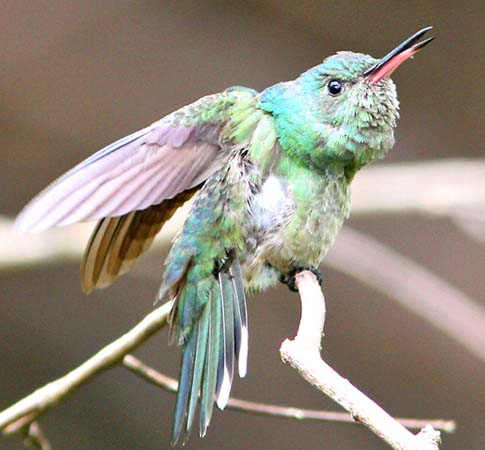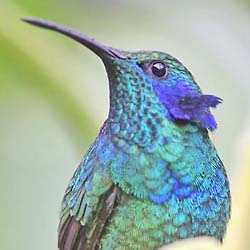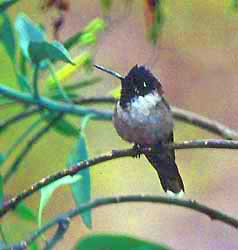
a web page by Don Roberson |
HUMMINGBIRDS Trochilidae |
||||
|
||||
 Colorful,
combative, and energetic, hummingbirds are among the world's most
popular birds. They are found only in the New World. People across
North America attract them to their homes through hummingbird feeders
and flowering gardens, and can be rewarded with bright migratory
species, such as a male Rufous Hummingbird (left).
Yet the true center of trochilid diversity is in the Neotropics, home
to a dazzling array of species that range from tiny to surprisingly
large, and with an assortment of head plumes, tail streamers, and bill
shapes. Their ability to hover and fly backwards makes them unique.
Further, their interdependence on and co-evolution with flowers provide
a fascinating correlation and field for study. Because the sources of
nectar are constantly changing as flowers bloom and fade, most
hummingbirds live solitary lives, aggressively defending nectar sources
from rivals. Despite the strong pressure to gather nectar rapidly,
studies have shown that 70% of a hummer's time is spent doing little
else than singing, self-preening, and sunbathing (Schuchmann 1999). In
the two shots below, a male White-necked Jacobin sits
near its favored feeder in Trinidad (below left) but immediately reacts
when a White-chested Emerald tries to approach. Such interactions can
lead to dramatic interspecific aerial chases. Colorful,
combative, and energetic, hummingbirds are among the world's most
popular birds. They are found only in the New World. People across
North America attract them to their homes through hummingbird feeders
and flowering gardens, and can be rewarded with bright migratory
species, such as a male Rufous Hummingbird (left).
Yet the true center of trochilid diversity is in the Neotropics, home
to a dazzling array of species that range from tiny to surprisingly
large, and with an assortment of head plumes, tail streamers, and bill
shapes. Their ability to hover and fly backwards makes them unique.
Further, their interdependence on and co-evolution with flowers provide
a fascinating correlation and field for study. Because the sources of
nectar are constantly changing as flowers bloom and fade, most
hummingbirds live solitary lives, aggressively defending nectar sources
from rivals. Despite the strong pressure to gather nectar rapidly,
studies have shown that 70% of a hummer's time is spent doing little
else than singing, self-preening, and sunbathing (Schuchmann 1999). In
the two shots below, a male White-necked Jacobin sits
near its favored feeder in Trinidad (below left) but immediately reacts
when a White-chested Emerald tries to approach. Such interactions can
lead to dramatic interspecific aerial chases. |
||||
|
||||
| A male Magnificent Hummingbird sitting in the shade (below left) can look dark and dingy. But when the hummer sits in the sun, and turns its head (below right), the observer is suddenly dazzled by a flash of spectacular glittering color. This species ranges from the southwest United States to Panama, and is a big hit at feeders from Ramsey Canyon, Arizona, to Savegre, Costa Rica. | ||||
|
||||
| Iridescent color among birds is one of nature's wonders, and hummingbirds display a full spectrum. For many species, iridescence is limited to a throat gorget, or a gorget and crown. North American examples include Anna's Hummingbird, the resident species throughout much of California (below, top row left) and Costa's Hummingbird of the southwestern deserts (below, top row right). On others the entire body is jeweled with waves of color, like on Violet Sabrewing (bottom row, below). | ||||
|
||||
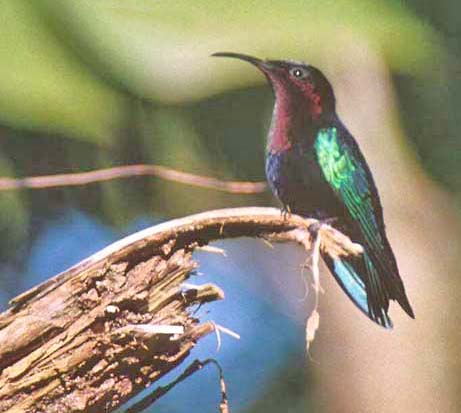 The
Neotropics are inhabited by a host of hummingbirds. Colorful species
buzz about rainforest trees and visit flowers at timberline on Andean
volcanoes. The Caribbean islands have their own fine assortment,
including Purple-throated Carib (right), this one on
Dominica. In my meanderings around the Neotropics, there have been many
wonderful species, such as the Horned Sungem Heliactin cornuta
recently seen in southern Brazil. Three species have particularly
impressed me with their unbelievable beauty, and all have been in the
western Andes of Colombia or northwestern Ecuador. I have photos of
none of these, but nothing can beat a Velvet-purple Coronet Boissonneaua jardini, or a Purple-backed Thornbill Ramphomicron microrhynchum, or a Rainbow-bearded Thornbill Chalcostigma herrani.
Try to see one if you have the chance. The names of hummingbirds alone
set one's head spinning: sunangels, comets, pufflegs, fairies,
starfrontlets, brilliants, mountain-gems, coquettes .... The
Neotropics are inhabited by a host of hummingbirds. Colorful species
buzz about rainforest trees and visit flowers at timberline on Andean
volcanoes. The Caribbean islands have their own fine assortment,
including Purple-throated Carib (right), this one on
Dominica. In my meanderings around the Neotropics, there have been many
wonderful species, such as the Horned Sungem Heliactin cornuta
recently seen in southern Brazil. Three species have particularly
impressed me with their unbelievable beauty, and all have been in the
western Andes of Colombia or northwestern Ecuador. I have photos of
none of these, but nothing can beat a Velvet-purple Coronet Boissonneaua jardini, or a Purple-backed Thornbill Ramphomicron microrhynchum, or a Rainbow-bearded Thornbill Chalcostigma herrani.
Try to see one if you have the chance. The names of hummingbirds alone
set one's head spinning: sunangels, comets, pufflegs, fairies,
starfrontlets, brilliants, mountain-gems, coquettes .... |
||||
| Unusual beaks and strange tails are part of the world of tropical hummingbirds. The bill of White-tipped Sicklebill (below left) is adapted best for Heliconia flowers. By far the longest bill, proportionate to size, belongs to the ridiculously unbalanced Sword-billed Hummingbird (below right) of the high Andes. It is adapted for feeding on exceptionally long tubular flowers. | ||||
|
||||
|
||||
|
||||
All hermits that have been studied display in noisy leks, their clicking dominating a patch of jungle. Hermits often have a species affinity for Heliconia plants and it can be rewarding to "stake-out" a patch inside the forest. This Rufous-breasted (or Hairy) Hermit (right) was sitting right next to 'his' Heliconia. Unlike many other hummingbirds, hermits are generally not territorial and few species have iridescence. When present, it is limited to the throat or crown. Nonetheless, it is obvious that hermits are hummingbirds, and even the most jaded "I can't tell one bird from another" non-naturalist can identify a hummingbird as such. |
||||
|
||||
Of course, not all hummingbirds are tropical, or appear to defy the laws of proportions, nor are all bright and colorful. Females and youngsters are often plainly-colored, particularly among the migratory species of North America This cryptic coloring can be important because only females sit on the nest, and if they were bright then they or the nestlings might more easily become prey. Hummingbird nests are often beautifully spun, like those of my local Anna's Hummingbird (above left) or the lichen-covered nest with almost-ready-to-fledge juvenal Costa's Hummingbirds (above right; it actual represents the first documented nesting in Monterey County, California). Schuchmann (1999) summarizes hummingbird breeding biology this way: "Male hummingbirds are polygamous, mating with several females during a reproductive period. In most species studied the male associates with the female only during a short period to fertilize her eggs. All remaining reproductive responsibilities like nest building, incubation, and rearing the young are carried out solely by the female." He goes on to cite a few reports of males participating in incubation or rearing the young, particularly in some tropical species, but generally concludes that there is insufficient evidence to confirm any parental care by males. What then am I to make of this photo I took in Costa Rica? It appears to show a male Blue-throated Goldentail incubating a nest. The hummer is certainly this species and seems to be in male plumage with a glittering deep-blue throat. This is a lekking species, so why would a male be incubating? May females occasionally attain a male-like plumage? There are many mysteries here. |
||||
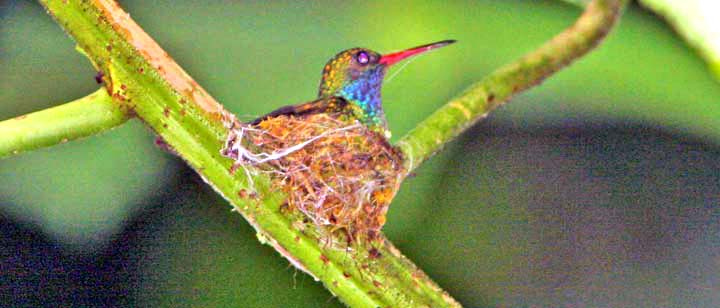 |
||||
The field identification of female North American hummingbirds is one of our most difficult problems. Stiles (1971, 1972), Baltosser (1987), Jones (1992), Heidcamp (1997), and, particularly Howell (2002) are useful sources. |
||||
While some hummingbirds are reasonably widespread (e.g., Scaly-breasted Hummingbird (left, in display), many hummingbirds are endemics, limited to single Caribbean islands, or isolated mountain chains.. Some of these are threatened with extinction: 29 species are listed as endangered or vulnerable by Birdlife International. Surely the most sought-after of them all – rare, endangered, spectacular, and limited to a very small range in northern Peru – is Marvelous Spatuletail, shown below in a collage. I've taken two of my photos from Huembo Reserve and combined them so that both side of this wonderful species can be shown in one photo. A separate page focused on this prized species, created long before my visit, has photos by James Hecht, taken at a time before the Reserve was created. |
||||
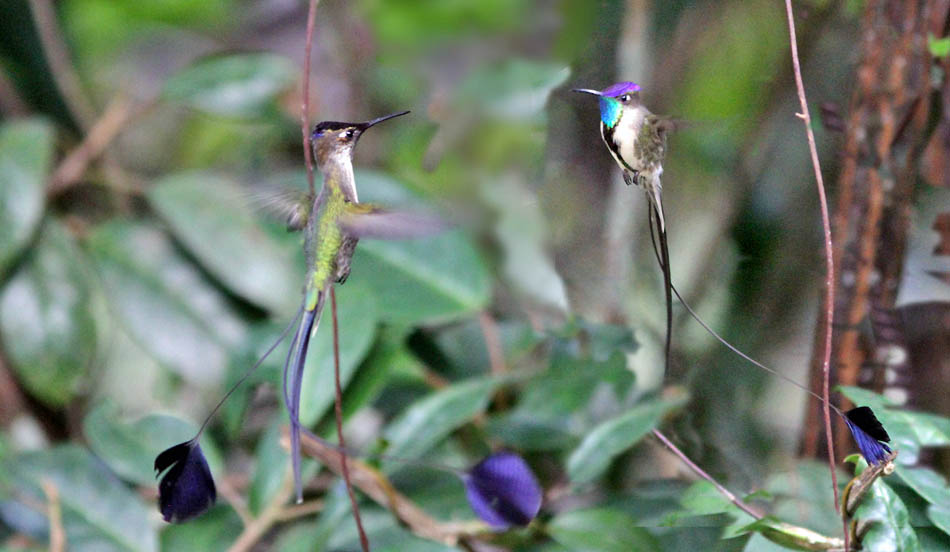 |
||||
|
||||
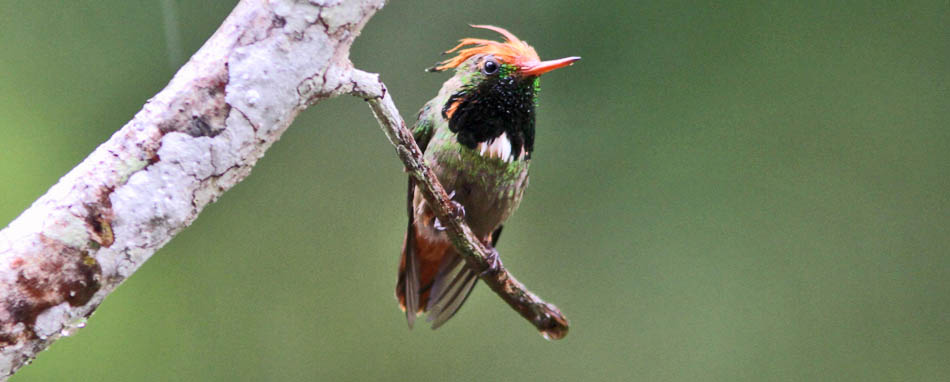 |
||||
Photos: The male Rufous Hummingbird Selasphorus rufous was in my Pacific Grove front yard in California in March 2006. The White-naped Jacobin Florisuga mellivora was at Asa Wright Nature Reserve on Trinidad in Dec 2006. Both shots of Magnificent Hummingbird Eugenes fulgens were at Savegre, Costa Rica, on 24 Dec 2007. The male Anna's Hummingbird Calypte anna was on her nest at Carmel R. mouth, Monterey Co., Calif., 22 Mar 2007, and the male Costa's Hummingbird Calypte costae was in Anza-Borrego SP, Calif., in April 2006. The Violet Sabrewing Campylopterus hemileucurus was at Mirador Cinchona, Costa Rica, on 19 Dec 2007. The Purple-throated Carib Eulampis jugularis was on Dominica in March 2000. The White-tipped Sicklebill Eutoxeres aquila was roosting over the Rio Pizore, Osa Peninsula, Costa Rica, on 26 Dec 2007. The Sword-billed Hummingbird Ensifera ensifera was at Owlet Lodge, Peru, 22 Nov 2014. The female Great Sapphirewing Pterophanes cyanopterus was below Abre Malaga, Dept. Cusco, Peru, on 15 June 1987. The female Tufted Coquette Lophornis ornatus was at Asa Wright Nature Reserve, Trinidad, in Dec 2006. The Black-crested Coquette Lophornis helenae was near Braulio Carrillo NP, Costa Rica, on 18 Dec 2007. The Rufous-breasted Hermit Glaucis hirsuta was at Asa Wright Nature Reserve, Trinidad, in Dec 2006. The female Anna's Hummingbird Calypte anna was on her nest at Soberanes Pt., Monterey Co., Calif., in May 1991. The nest of Costa's Hummingbird Calypte costae was in Bixby Canyon, Monterey Co., on 30 June 1981. The incubating Blue-throated Goldentail Hylocharis eliciae was near the Rio Rincon, Osa Peninsula, Costa Rica, on 27 Dec 2007. The male Ruby-throated Hummingbird Archilochus colubris was at Arroyo Grande, Calif., on 4 Sep 2014. The displaying male Scaly-breasted Hummingbird Amazilia boucardi was at Rio Rincon, Osa Peninsula, Costa Rica, on 27 Dec 2007. The Marvelous Spatuletail Loddigesia mirabilis collage is from photos at Huemba Reserve, Amazonas, Peru, in Nov 2014. The Green Violetear Colibri thalassinus was at Savegre, Costa Rica, on 24 Dec 2007. The Bearded Mountaineer Oreonympha nobilis was at Uripichancha, Peru, on 13 June 1987. The Rufous-crested Coquette Lophornis delattrei was at Waqanki, Peru, in Nov 2014.
Bibliographic note:
Although hummingbirds have inspired hundreds of books, there is no
single family book. Such a work would be a difficult undertaking, since
hummingbirds are the second largest family in the New World (after
flycatchers) with over 330 species. Between 1849 and 1861, John Gould
published a five volume Hummingbirds series totaling 418
lithographed plates capturing the beauty and aerial artistry of many
South American hummers (now reprinted as Gould 1990). For many years,
this was the major work on the family until Crawford Greenewalt (1960)
published a spectacular set of color "stop-action" photographs of South
American hummingbirds (Greenewalt's pioneering volume is now rare and
expensive). Numerous other such books followed using strobe-flash
technology to capture hummers in mid-flight, including Scheithauer
(1966) and Dunning (1970) who included incredible Andean species, or
Keppelman (1988) on southeast Arizona. I have found that by far the
most useful for detailed identification purposes for North American
species is Tyrell & Tyrell (1985), not because of the text (which
is very general) but because the excellent photo quality is often
sufficient to determine points like wing formula and remige or rectrix
shape. Literature cited:
|
||||


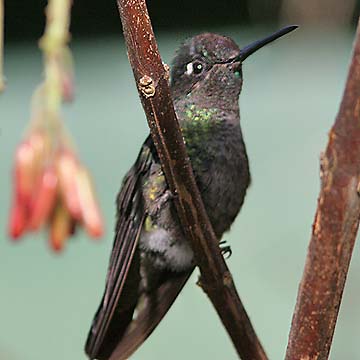
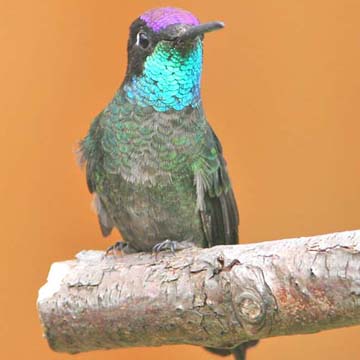
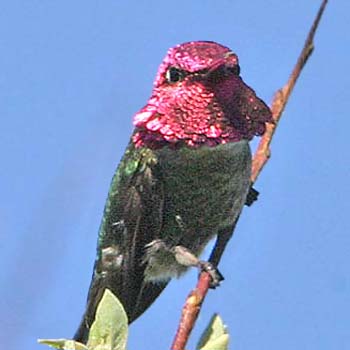
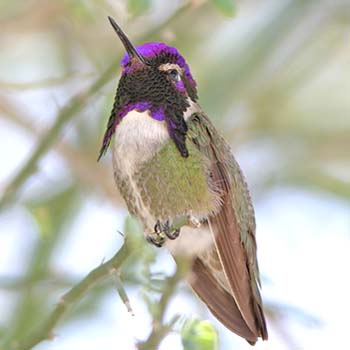
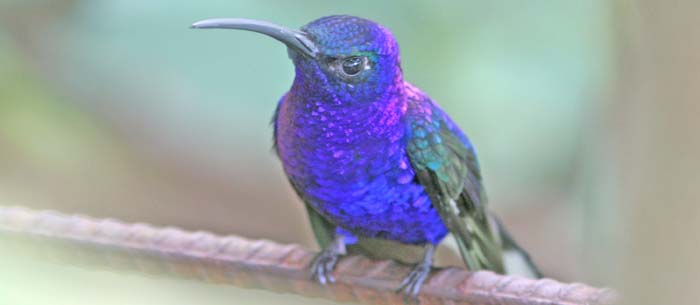
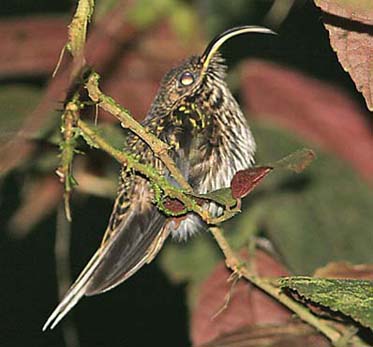
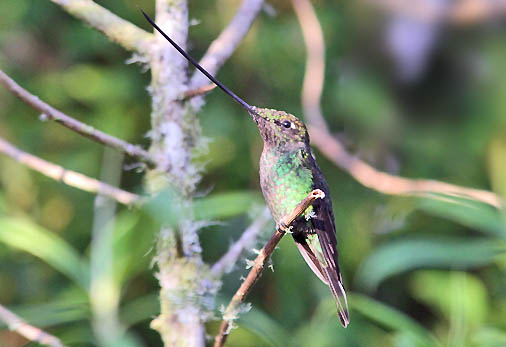
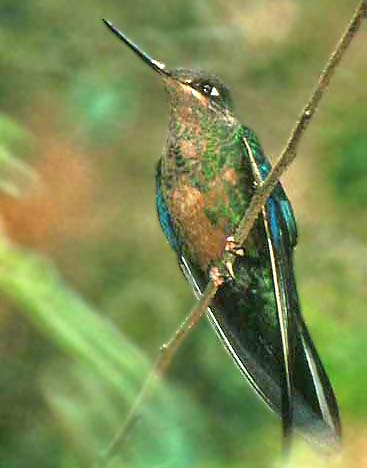
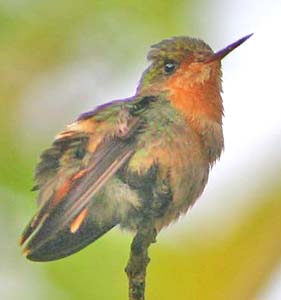

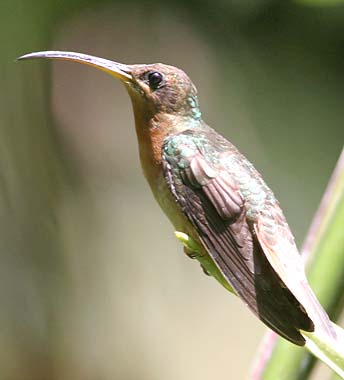 Despite
the many species of hummingbirds, they are divided into just two
subfamilies (Schuchmann 1999). The Trochilinae include all the colorful
species (nearly 300 in all) while the Phaethornithinae is composed of
the six genera and 34 species of hermits. Brown, long-tailed hermits
forage in the understory; some short-tailed species weigh only 1.6 gram
(the same weight as the tiny Bee Hummingbird Mellisuga helenae of Cuba, often termed the "world's smallest bird").
Despite
the many species of hummingbirds, they are divided into just two
subfamilies (Schuchmann 1999). The Trochilinae include all the colorful
species (nearly 300 in all) while the Phaethornithinae is composed of
the six genera and 34 species of hermits. Brown, long-tailed hermits
forage in the understory; some short-tailed species weigh only 1.6 gram
(the same weight as the tiny Bee Hummingbird Mellisuga helenae of Cuba, often termed the "world's smallest bird"). 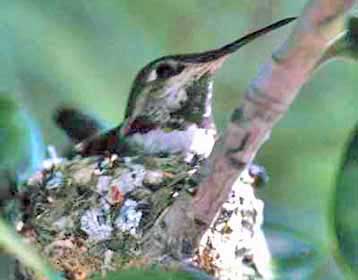
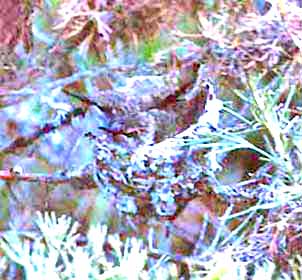
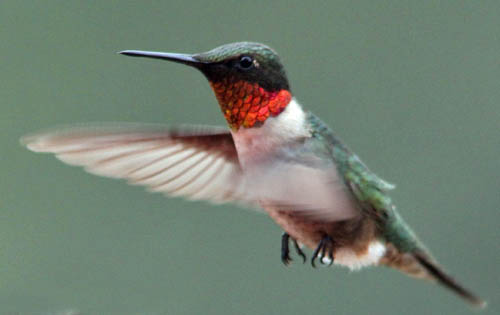 Many
North American hummingbirds are migratory, including Rufous Hummingbird
shown at the top of this account. Migratory hummers are susceptible to
vagrancy, accounting for the variety of species that have reached
California, including several Ruby-throated Hummingbird,
one of which is shown at right (in Brad Schram's yard in San Luis
Obispo Co.). Surely the most unexpected was Xantus's Hummingbird Hylocharis xantusii
from southern Baja California; one female built a nest and laid eggs in
Ventura Co. (Hainebach 1992). The only Blue-throated Hummingbird Lampornis clemenciae
to reach California – in Tulare Co. from Dec 1977-May 1978 — not only
built a nest and laid eggs, but fledged three young! These appeared to
be Blue-throated X Anna's hybrids (Baldridge et al. 1983).
Many
North American hummingbirds are migratory, including Rufous Hummingbird
shown at the top of this account. Migratory hummers are susceptible to
vagrancy, accounting for the variety of species that have reached
California, including several Ruby-throated Hummingbird,
one of which is shown at right (in Brad Schram's yard in San Luis
Obispo Co.). Surely the most unexpected was Xantus's Hummingbird Hylocharis xantusii
from southern Baja California; one female built a nest and laid eggs in
Ventura Co. (Hainebach 1992). The only Blue-throated Hummingbird Lampornis clemenciae
to reach California – in Tulare Co. from Dec 1977-May 1978 — not only
built a nest and laid eggs, but fledged three young! These appeared to
be Blue-throated X Anna's hybrids (Baldridge et al. 1983).